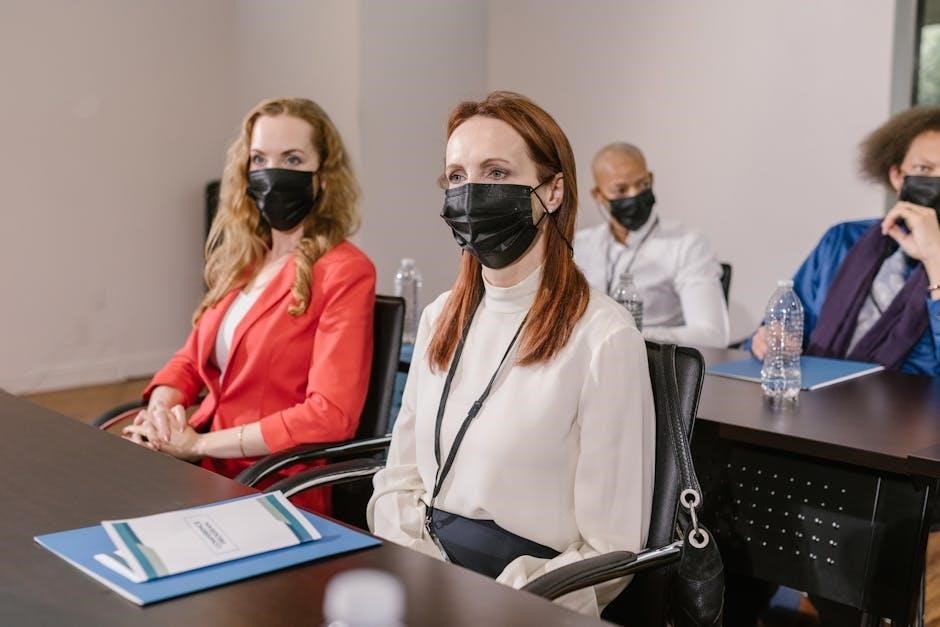available online, including a pdf by Patrick Lencioni, a renowned expert in team management and leadership development strategies always.
Overview of the Concept
The concept of the 5 dysfunctions of a team is a framework for understanding and addressing the common pitfalls that can hinder a team’s effectiveness. This concept is discussed in detail in the book by Patrick Lencioni, which is available as a pdf online. The idea is that when teams are dysfunctional, it can have a significant impact on the overall performance and success of an organization. The concept is based on the idea that teams are complex systems that require a deep understanding of human behavior and group dynamics. By understanding the 5 dysfunctions of a team, leaders and managers can take steps to prevent or overcome these challenges and build a more effective and cohesive team. The concept has been widely adopted and is considered a valuable resource for anyone looking to improve team performance and achieve their goals.

The Five Dysfunctions
Patrick Lencioni’s model outlines specific team dysfunctions in his pdf, including absence of trust and fear of conflict, affecting team performance and overall success always online.
Absence of Trust
The absence of trust is a fundamental dysfunction in teams, as outlined in Patrick Lencioni’s pdf, and it can have far-reaching consequences on team performance and overall success.
When team members do not trust each other, they are unlikely to engage in open and honest communication, which can lead to misunderstandings and conflicts.
Trust is the foundation of a healthy and functional team, and its absence can create an environment of suspicion and mistrust, making it difficult for teams to work together effectively.
According to Lencioni’s model, the absence of trust is the first and most critical dysfunction, as it can lead to a range of other problems, including fear of conflict, lack of commitment, and avoidance of accountability.
By addressing the absence of trust, teams can begin to build a stronger and more cohesive unit, which can ultimately lead to greater success and achievement.
Lencioni’s pdf provides valuable insights and practical advice on how to overcome the absence of trust and build a more trusting and collaborative team environment.

Characteristics of a Highly Effective Team
Highly effective teams exhibit traits like open communication, active participation, and collective accountability, as discussed in Patrick Lencioni’s pdf, fostering a positive and productive team environment always online.
Trust and Conflict
Trust and conflict are two essential components of a highly effective team, as outlined in the pdf by Patrick Lencioni, a renowned expert in team management and leadership development strategies.
Trust is the foundation of a strong team, and it is built when team members feel comfortable sharing their thoughts and ideas without fear of judgment or rejection.
Conflict, on the other hand, is a natural and necessary part of the team’s growth and development process, as it allows team members to challenge each other’s ideas and work towards a common goal.
When trust and conflict are present in a team, team members are more likely to engage in open and honest communication, which leads to better decision-making and problem-solving.
Effective teams also recognize that conflict is not a negative thing, but rather an opportunity for growth and improvement, and they work to resolve conflicts in a constructive and respectful manner.
By fostering an environment of trust and conflict, teams can overcome obstacles and achieve their goals, as discussed in the pdf, and become a highly effective and successful team.

Application of the Model
Leaders apply the model to improve team performance and effectiveness, using strategies from the pdf to overcome dysfunctions and achieve success always with online resources.
Real-World Examples
Many organizations have successfully applied the concepts from the pdf to overcome team dysfunctions and achieve success. Companies like Decision Tech have used the model to improve communication and trust among team members. The pdf provides case studies and examples of how the five dysfunctions can manifest in different teams and industries. Leaders can learn from these examples and apply the strategies to their own teams. The model has been used in various settings, including business, sports, and education. Real-world examples demonstrate the effectiveness of the model in improving team performance and achieving goals. By studying these examples, leaders can gain a deeper understanding of the five dysfunctions and how to overcome them. The pdf offers practical advice and guidance on how to apply the model in different contexts. Leaders can use these examples to develop their own strategies for building a high-performing team. The model has been widely adopted and has helped many teams to achieve success.
Understanding team dysfunctions is crucial, with the pdf providing valuable insights and strategies for leaders to build effective teams and achieve success always with proper planning and execution online.
Importance of Understanding the 5 Dysfunctions

The importance of understanding the 5 dysfunctions of a team cannot be overstated, as it is crucial for leaders to recognize and address these issues in order to build a highly effective team. By understanding the dysfunctions, leaders can take proactive steps to prevent them from occurring, or to mitigate their effects if they have already taken hold. This can be achieved by reading the pdf and other relevant materials, and by implementing the strategies and techniques outlined in them. The internet provides a wealth of information on this topic, including articles, blogs, and online courses. Leaders who take the time to educate themselves on the 5 dysfunctions of a team will be better equipped to build a strong, cohesive team that is capable of achieving great things. With this knowledge, leaders can create a positive and productive team culture, and can help their team members to reach their full potential. Effective teams are essential for the success of any organization, and understanding the 5 dysfunctions is a key part of building such a team.
